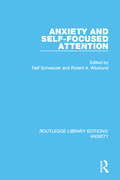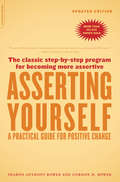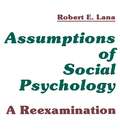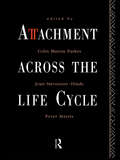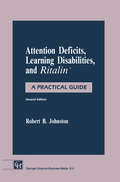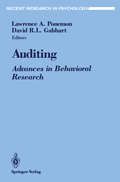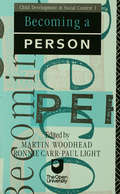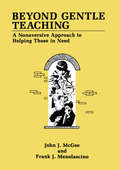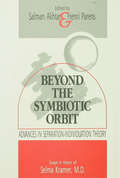- Table View
- List View
Anxiety and Self-Focused Attention (Routledge Library Editions: Anxiety)
by Ralf Schwarzer Robert A. WicklundFirst published in 1991, this book consists of 13 articles that were originally published in the journal Anxiety Research. They address the topic of anxiety and self-focused attention from a variety of perspectives, representing recent advances in social, clinical and personality psychology at the time. As a whole, the book poses a stimulating theoretical challenge to traditional anxiety research, which had been dominated by psychometric issues, clinical case studies and stable personality constructs. The contributors share the view that anxiety is an emotional state of distress dependent upon specific antecedent cognitive processes such as self-awareness, perceived role discrepancy or unfavourable expectancies.
Anxiety and Self-Focused Attention (Routledge Library Editions: Anxiety)
by Ralf Schwarzer Robert A. WicklundFirst published in 1991, this book consists of 13 articles that were originally published in the journal Anxiety Research. They address the topic of anxiety and self-focused attention from a variety of perspectives, representing recent advances in social, clinical and personality psychology at the time. As a whole, the book poses a stimulating theoretical challenge to traditional anxiety research, which had been dominated by psychometric issues, clinical case studies and stable personality constructs. The contributors share the view that anxiety is an emotional state of distress dependent upon specific antecedent cognitive processes such as self-awareness, perceived role discrepancy or unfavourable expectancies.
Architectures for Intelligence: The 22nd Carnegie Mellon Symposium on Cognition (Carnegie Mellon Symposia on Cognition Series)
by Kurt VanLehnThis unique volume focuses on computing systems that exhibit intelligent behavior. As such, it discusses research aimed at building a computer that has the same cognitive architecture as the mind -- permitting evaluations of it as a model of the mind -- and allowing for comparisons between computer performance and experimental data on human performance. It also examines architectures that permit large, complex computations to be performed -- and questions whether the computer so structured can handle these difficult tasks intelligently.
Architectures for Intelligence: The 22nd Carnegie Mellon Symposium on Cognition (Carnegie Mellon Symposia on Cognition Series)
by Kurt Van LehnThis unique volume focuses on computing systems that exhibit intelligent behavior. As such, it discusses research aimed at building a computer that has the same cognitive architecture as the mind -- permitting evaluations of it as a model of the mind -- and allowing for comparisons between computer performance and experimental data on human performance. It also examines architectures that permit large, complex computations to be performed -- and questions whether the computer so structured can handle these difficult tasks intelligently.
Artificial Believers: The Ascription of Belief
by Afzal Ballim Yorick WilksModeling of individual beliefs is essential to the computer understanding of natural languages. Phenomena at all levels -- syntactic, semantic, and pragmatic -- cannot be fully analyzed in the absence of models of a hearer and of the hearer's model of other believers. The heart of this text is the presentation of an artificial intelligence (AI) program intended to simulate certain aspects of a human believer. This book provides a prolog program, Viewgen, that maintains belief structures about the world and other believers, and is able to ascribe beliefs to others without direct evidence by using a form of default reasoning. The authors contend that a plausible model such as this can -- in the best cognitive science tradition -- shed light on the long-standing philosophical problem of what belief is. The issues presented here will be of considerable interest to an informed general reader as well as those with a background in any of the disciplines that make up what is now called cognitive science: philosophy, linguistics, psychology, neuropsychology, and also AI itself.
Artificial Believers: The Ascription of Belief
by Afzal Ballim Yorick WilksModeling of individual beliefs is essential to the computer understanding of natural languages. Phenomena at all levels -- syntactic, semantic, and pragmatic -- cannot be fully analyzed in the absence of models of a hearer and of the hearer's model of other believers. The heart of this text is the presentation of an artificial intelligence (AI) program intended to simulate certain aspects of a human believer. This book provides a prolog program, Viewgen, that maintains belief structures about the world and other believers, and is able to ascribe beliefs to others without direct evidence by using a form of default reasoning. The authors contend that a plausible model such as this can -- in the best cognitive science tradition -- shed light on the long-standing philosophical problem of what belief is. The issues presented here will be of considerable interest to an informed general reader as well as those with a background in any of the disciplines that make up what is now called cognitive science: philosophy, linguistics, psychology, neuropsychology, and also AI itself.
Asserting Yourself-Updated Edition: A Practical Guide For Positive Change
by Sharon Anthony Bower Gordon H. BowerThe classic best-selling step-by-step program for becoming more assertive. Utilizing a number of techniques from behavior-change psychology, speech, communications, and acting, the authors Sharon and Gordon Bower outline an effective assertiveness program to help people improve their self-esteem, articulate their opinions, and develop meaningful relationships. Exercises and examples throughout--including the celebrated DESC scripts (describe, express, specify, consequences)--allow readers to practice the program, adapt it to their own lives, and evaluate their progress. For both personal and professional use, Asserting Yourself is the classic guide to building confidence and taking a stand.
Assumptions of Social Psychology: A Reexamination
by Robert E. LanaThis book is a thorough revision of the successful Assumptions of Social Psychology, first published in 1969. Reexamining the implicit and explicit assumptions concerning inquiry as to the nature of the human organism, it takes as its major thesis the idea that the epistemologies utilized by social psychologists -- encompassing behavioral, intentional, and historical analyses -- are complementary rather than contradictory. After examining key figures in the history of Western epistemology, such as Descartes, Vico, Hume, and Kant, contemporary issues such as the nature of causation, intentions, behavior, rhetoric, and hermeneutics are discussed. A major thesis is that the epistemologies utilized by social scientists encompassing behavioral, cognitive, and historical analyses are complimentary rather than contradictory. In order to demonstrate this, the historical underpinnings of social psychological epistemologies and an argument for the complimentarity of major social psychological theoretical approaches are developed. Most importantly, some of the possibilities for building explanation of social phenomena, which are alternatives to existing forms of explanation, are discussed.
Assumptions of Social Psychology: A Reexamination
by Robert E. LanaThis book is a thorough revision of the successful Assumptions of Social Psychology, first published in 1969. Reexamining the implicit and explicit assumptions concerning inquiry as to the nature of the human organism, it takes as its major thesis the idea that the epistemologies utilized by social psychologists -- encompassing behavioral, intentional, and historical analyses -- are complementary rather than contradictory. After examining key figures in the history of Western epistemology, such as Descartes, Vico, Hume, and Kant, contemporary issues such as the nature of causation, intentions, behavior, rhetoric, and hermeneutics are discussed. A major thesis is that the epistemologies utilized by social scientists encompassing behavioral, cognitive, and historical analyses are complimentary rather than contradictory. In order to demonstrate this, the historical underpinnings of social psychological epistemologies and an argument for the complimentarity of major social psychological theoretical approaches are developed. Most importantly, some of the possibilities for building explanation of social phenomena, which are alternatives to existing forms of explanation, are discussed.
Atlas of Brain Mapping: Topographic Mapping of EEG and Evoked Potentials
by Konrad Maurer Thomas DierksFrom its discovery in 1929 by Hans Berger until the late 1960s, when sensory visual and auditory evoked potentials were dis covered and became popular, the EEG was the most important method of neurophysiological examination. W-ith the advent of computer technology in the 1980s, it became possible to plot the potential fields of the EEG onto models of the scalp. This plot ting of information as neuroimages followed the structural and functional techniques of Cf, MRI, PET and SPECf. The success of this method, which began in the early 1980s, has led to the brain mapping of EEGs and EPs being increasingly used for di agnosistic purposes in neurology, psychiatry and psychopharma cology. The pioneers of this method believed in it and were commit ted to its success. However, many traditionalists felt that it gave no new information and so regarded the method with scepticism. Some found both the coloured maps and the mapping technique misleading, which led to unnecessary conflict between mappers and their chromophobic oponents. Emotions have run so high that some professional bodies have justifiably adopted guidelines and warned of the misuse of the method.
Attachment Across the Life Cycle (PDF)
by Colin Murray Parkes Joan Stevenson-Hinde Peter MarrisIt has long been suspected that many of the common psychiatric and social problems of adult life have their roots in the early relationship between the child and its mother. To explain this simple observation and to examine the part which these patterns of attachment play in the causation of psychiatric and social problems, a body of knowledge has sprung up which owes much to the pioneering work of the late John Bowlby. This book draws together recent theoretical contributions, research findings and clinical data from psychiatrists, psychologists, sociologists and ethnologists from Britain, America and Europe. Their work has confirmed the importance of the earlier research and extended it to cover attachment throughout the life cycle.
Attention Deficits, Learning Disabilities, and Ritalin™: A Practical Guide (pdf)
by Robert B. JohnstonAuditing: Advances in Behavioral Research (Recent Research in Psychology)
by David R. L.Gabhart Lawrence A. PonemonThis book has been prepared for those readers who want to maintain their knowledge of current developments in the field of behavioral research as applied to auditing. The articles and papers presented in this volume were selected because they will contribute to the knowledge and advancement of not only the individual researcher or educator, but also of the profession. It is our belief that if research endeavors may be viewed as having stages of life, then the field of behavioral research in auditing is in its genesis. Almost twenty years ago, in speaking of the state of the art of psychology, William Hays expressed a most·appropriate thought: Experimental evidence is accumulating at a rapid rate in psychology, and efforts at constructing psychological theories with mathematical deductive power are constantly being made. However, it seems safe to say that it will be sometime before there are psychological laws and theories on a par with those of physics. The absence of a general theory does not imply that those relations are missing or unhpportant in psychology; the discovery and specification of relations is the process by which those theories are built. (Hays, 1973, p. 40.) In the first chapter, "Experimental Research and the Distinctive Features of Accounting Settings," Robert Libby presents an encompassing and knowledgeable summary of the changes that have taken place during the last decade in human information processing research in accounting and experimental economics as it relates to those issues.
Autogenes Training aus der Praxis: Ein Gruppenkurs
by Günther KrapfDas Autogene Training zählt zu den "Übenden Methoden" der allgemeinen Psychotherapie: Mit Hilfe stufenweise erlernbarer Übungen und durch deren ständiges Training kann durch konzentrative Entspannung eine Form der Selbsthypnose erzielt werden, die es ermöglicht, Zustände körperlicher und seelischer Unausgeglichenheit aufzulösen. Dieses Buch kann und will nicht mehr geben als Information. Eine persönliche Unterweisung durch einen in der Methode ausgebildeten Lehrer kann es nicht ersetzen. Der Autor, Arzt und Psychotherapeut in München, schildert nach einer theoretischen Einführung in Wesen, Ziel und Möglichkeiten des Autogenen Trainings einen Gruppenkurs, wie er sich in seiner Praxis seit langem bewährt. Moderne Erkenntnisse der Gruppen- und Tiefenpsychologie gehen in diesem auch für den interessierten Laien verständlich geschriebenen Buch eine glückliche Verbindung ein.
The Basic Writings of C.G. Jung: Revised Edition (Bollingen Series #666)
by C. G. JungIn exploring the manifestations of human spiritual experience both in the imaginative activities of the individual and in the formation of mythologies and of religious symbolism in various cultures, C. G. Jung laid the groundwork for a psychology of the spirit. The excerpts here illuminate the concept of the unconscious, the central pillar of his work, and display ample evidence of the spontaneous spiritual and religious activities of the human mind. This compact volume will serve as an ideal introduction to Jung's basic concepts. Part I of this book, "On the Nature and Functioning of the Psyche," contains material from four works: "Symbols of Transformation," "On the Nature of the Psyche," "The Relations between the Ego and the Unconscious," and "Psychological Types." Also included in Part I are "Archetypes of the Collective Unconscious" and "Psychological Aspects of the Mother Archetype." Part II, "On Pathology and Therapy," includes "On the Nature of Dreams," "On the Pathogenesis of Schizophrenia," and selections from "Psychology of the Transference." In Part III appear "Introduction to the Religious and Psychological Problems of Alchemy" and two sections of "Psychology and Religion." Part IV, called "On Human Development," consists of the essay "Marriage as a Psychological Relationship."
Becoming A Person
by Martin Woodhead Ronnie Carr Paul Charles LightThe first volume of readings for the Child Development in Social Context series concentrates on the imporatnce of social relationships in the young child's life. Early readings summarise recent research on childres's emotional attachments. But relationships are also the context of much of their early play and learning. There are readings to illustrate how parents 'frame' , guide and 'scaffold' young children's development, with special reference to the way childfren are intiated into using language as a tool for learning. The cross- cultural dimension of early development is a particular focus of this volume, which concludes with readings on the construction of personal identity. First published in 1991. Routledge is an imprint of Taylor & Francis, an informa company.
Becoming A Person (PDF)
by Martin Woodhead Ronnie Carr Paul Charles LightThe first volume of readings for the Child Development in Social Context series concentrates on the imporatnce of social relationships in the young child's life. Early readings summarise recent research on childres's emotional attachments. But relationships are also the context of much of their early play and learning. There are readings to illustrate how parents 'frame' , guide and 'scaffold' young children's development, with special reference to the way childfren are intiated into using language as a tool for learning. The cross- cultural dimension of early development is a particular focus of this volume, which concludes with readings on the construction of personal identity. First published in 1991. Routledge is an imprint of Taylor & Francis, an informa company.
Behavioral and Biochemical Issues in Substance Abuse
by Doris Clouet Frank R George Barry StimmelThis excellent book is a concise yet thorough examination of the important and emerging field of the study of biological risk factors in drug abuse. Historically, drug abuse research has concentrated on the contributions of environmental and behavioral factors as the major influences on addiction. The revelatory studies in this volume examine the genetic contributions to drug taking behavior through the use of animal models, cellular experiments and human clinical studies. Behavioral and Biochemical Issues in Substance Abuse provides for the first time in one volume, up-to-date, easily digested reviews of topics concerning biological and genetic factors in drug abuse. Medical researchers in all areas of alcoholism and drug abuse, researchers in pharmacology, psychology, psychiatry and neuroscience, and clinicians interested in biological approaches to alcoholism and drug abuse problems will benefit greatly from this valuable resource. Authoritative contributors clearly demonstrate the capability of genetic factors to modulate the reinforcing or rewarding effects of drugs, thereby altering their addictive potential. In addition to gaining comprehension of the biological factors affecting addiction, a greater understanding of genetics related to drug abuse will enable future research to control biological factors, leading to more accurate studies of behavioral and environmental influences on drug and alcohol abuse.
Behavioral and Biochemical Issues in Substance Abuse
by Doris Clouet Frank R George Barry StimmelThis excellent book is a concise yet thorough examination of the important and emerging field of the study of biological risk factors in drug abuse. Historically, drug abuse research has concentrated on the contributions of environmental and behavioral factors as the major influences on addiction. The revelatory studies in this volume examine the genetic contributions to drug taking behavior through the use of animal models, cellular experiments and human clinical studies. Behavioral and Biochemical Issues in Substance Abuse provides for the first time in one volume, up-to-date, easily digested reviews of topics concerning biological and genetic factors in drug abuse. Medical researchers in all areas of alcoholism and drug abuse, researchers in pharmacology, psychology, psychiatry and neuroscience, and clinicians interested in biological approaches to alcoholism and drug abuse problems will benefit greatly from this valuable resource. Authoritative contributors clearly demonstrate the capability of genetic factors to modulate the reinforcing or rewarding effects of drugs, thereby altering their addictive potential. In addition to gaining comprehension of the biological factors affecting addiction, a greater understanding of genetics related to drug abuse will enable future research to control biological factors, leading to more accurate studies of behavioral and environmental influences on drug and alcohol abuse.
Behavioral Aspects of Cardiovascular Disease (Perspectives on Behavioral Medicine Series)
by Alvin P. Shapiro Andrew BaumSmoking, diet, stress, coping, and exercise, among other behaviors and psychological states, are now clearly implicated in the development of cardiovascular diseases. Prevention, based largely on altering behaviors that contribute to this chronic disease, is now as important a goal as is treatment of those already afflicted. This volume, based on a recent meeting of the Academy of Behavioral Medicine Research, addresses several important areas of research in the general area of cardiovascular disease. The topics covered reflect on important aspects of this phenomenon, such as the long-term development of coronary artery disease; central nervous system (CNS) regulation of blood pressure, heart rate, and sympathetic tone playing a pivotal role in sympathetic activity and hypertension; learned blood pressure modulation and baroreceptor activation as a means of reducing the aversiveness of stress or noxious stimulation; and the notion that symptoms of heart disease or infarction may occur in the absence of organic heart disease. Having been impressed by the recent advances in the field, the editors of this book capture the wealth of newly acquired knowledge about behavioral factors in cardiovascular disease and how the body's nervous, endocrine, and cardiovascular systems work together.
Behavioral Aspects of Cardiovascular Disease (Perspectives on Behavioral Medicine Series)
by Alvin P. Shapiro Andrew S. BaumSmoking, diet, stress, coping, and exercise, among other behaviors and psychological states, are now clearly implicated in the development of cardiovascular diseases. Prevention, based largely on altering behaviors that contribute to this chronic disease, is now as important a goal as is treatment of those already afflicted. This volume, based on a recent meeting of the Academy of Behavioral Medicine Research, addresses several important areas of research in the general area of cardiovascular disease. The topics covered reflect on important aspects of this phenomenon, such as the long-term development of coronary artery disease; central nervous system (CNS) regulation of blood pressure, heart rate, and sympathetic tone playing a pivotal role in sympathetic activity and hypertension; learned blood pressure modulation and baroreceptor activation as a means of reducing the aversiveness of stress or noxious stimulation; and the notion that symptoms of heart disease or infarction may occur in the absence of organic heart disease. Having been impressed by the recent advances in the field, the editors of this book capture the wealth of newly acquired knowledge about behavioral factors in cardiovascular disease and how the body's nervous, endocrine, and cardiovascular systems work together.
Behavioral Biology: Neuroendocrine Axis
by Trevor Archer Stefan HansenThis book is the result of an international symposium in biological psychology, held in honor of Knut Larsson. This renowned researcher -- in his search for the true meaning of "mind vs. matter" -- became involved in many divergent areas of the field, such as the neurobiology of sexual behavior and sexual differentiation, aspects of functional neuroanatomy, behavioral endocrinology, and psychopharmacology. Through experimentation and much consultation with other area specialists, Larsson observed such phenomena as the adaptation of behavior-determining neuroendocrine events to the physical environment and the hormonal regulation of sexual behavior and differentiation. This tribute to his research presents important features of necessary paradigms for the analysis and study of experimental psychology within the biological perspective.
Behavioral Biology: Neuroendocrine Axis
by Trevor Archer Stefan HansenThis book is the result of an international symposium in biological psychology, held in honor of Knut Larsson. This renowned researcher -- in his search for the true meaning of "mind vs. matter" -- became involved in many divergent areas of the field, such as the neurobiology of sexual behavior and sexual differentiation, aspects of functional neuroanatomy, behavioral endocrinology, and psychopharmacology. Through experimentation and much consultation with other area specialists, Larsson observed such phenomena as the adaptation of behavior-determining neuroendocrine events to the physical environment and the hormonal regulation of sexual behavior and differentiation. This tribute to his research presents important features of necessary paradigms for the analysis and study of experimental psychology within the biological perspective.
Beyond Gentle Teaching: A Nonaversive Approach to Helping Those in Need
by J.J. McGee F.J. MenolascinoThis book is for caregivers: those who care for and about children and adults who reside on the very edge of family and community life. It is for those who not only want to help these distanced individuals but for those who also want to change themselves in the process. It is for parents, teachers, direct care workers, coun selors, social workers, psychologists, psychiatrists, advocates, and all who strive to bring about just treatment for the marginalized. It is for those who want to consider a psychology based on inter dependence and to uncover ways to express and practice compan ionship instead of control. It is about children and adults who live in marginalized conditions, who are pushed and pulled away from feelings of union and hurt themselves, hurt others, or simply give up. It is for those who live and work among the mentally retarded, the mentally ill, the aged, the homeless, and the poor. To be marginalized is to be easily controlled, isolated, and segregated.
Beyond the Symbiotic Orbit: Advances in Separation-Individuation Theory: Essays in Honor of Selma Kramer, MD
by Salman Akhtar Henri ParensIn this tribute to Selma Kramer, eminent child analyst and colleague and close friend of the late Margaret Mahler, senior analysts explore the continuing relevance of Mahler's separation-individuation theory to developmental and clinical issues. Editors Salman Akhtar and Henri Parens have grouped the original contributions to Beyond the Symbiotic Orbit into sections that reevaluate Mahler's theory. Section I is a timely reassessment of Mahler's working model from the standpoint of contemporary clinical and research findings. It includes comparisons of Mahler with Winnicott and Kohut, and commentaries on the status of separation-individuation theory in relation to psychosexual theory, early ego development, and observational infancy research. Section II addresses the contribution of separation-individuation theory to our understanding of pathogenesis. Neurosis, severe character pathology, psychosomatic phenomena, eating disorders, and sexual perversions are among the topics of specific chapters. The final section explores the role of separation-individuation theory in the treatment of analysands of different ages and with different kinds of psychopathology; it also considers separation-individuation theory with respect to specific aspects of the treatment process, including reconstruction, transference, and termination. A fresh reappraisal of a major perspective on early development, Beyond the Symbiotic Orbit is a fitting testimonial to Selma Kramer, who has played so important a role in elaborating Mahler's theory. Following from Kramer's own example, the contributors show how separation-individuation theory, in its ability to accomodate ongoing clinical and research findings, is subject to continuing growth and refinement. They not only advance our understanding of Mahler's working model, but pursue the implications of this model in new directions, underscoring the many areas of exploration that separation-individuation theory opens to us.
